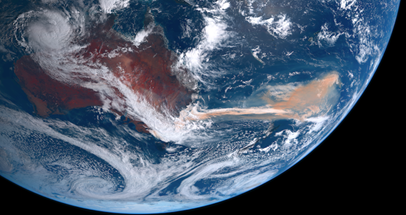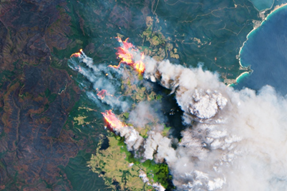According to a new international study co-led by BSC, the aerosol particles emitted by the fires caused a widespread increase in marine microscopic algae thousands of kilometers away from Australia.
Between October 2019 and February 2020, fires burned in Australia like never before. More than 18 million hectares, two times the surface of Portugal, were ravaged in the forests of the southeast of the country in an unprecedented fire season with strong ecological impacts, including loss of biodiversity and habitats, as well as hazardous air pollution. The megafires emitted large clouds of ash and smoke that contained fire aerosols, which are particles from the burned biomass that are small enough to travel in the air.
Pushed by the predominant westerly winds, the plumes of ash and smoke carrying these particles travelled to the east crossing New Zealand, the Pacific Ocean and reaching Chile and beyond. In a process called deposition, the same that leaves our cars brown and dirty when Saharan dust is transported over Europe, the aerosols fell over the ground and the ocean thousands of kilometres away from Australia.
Now, an international study co-led by scientists from the Barcelona Supercomputing Center (BSC) and Duke University (USA) demonstrates that some of the aerosols that fell into the Pacific Ocean triggered a widespread increase in microscopic marine algae called phytoplankton. In other words, wildfires' aerosols fertilised the ocean similarly to when nutrients are added to agricultural grounds to help vegetables grow. In an oceanic region seen as a marine desert because it holds a very low concentration of phytoplankton, the response was equivalent to turning the whole Sahara Desert into grassland for at least 4 months.
“In the study we combined very different techniques, such as satellite data, atmospheric models, autonomous marine robots, and aerosol sampling, to demonstrate that the phytoplankton response was mostly due to the amount of iron contained in the fire aerosols,” explained Joan Llort, researcher at the BSC Earth Sciences Department and co-leading author of the study, which has been published in Nature.
“We incorporated the global CAMS model reanalysis (developed by Copernicus, the European Union's Earth observation programme) for giving us a broader view of the spread of the fire ash plume,” added Sara Basart, researcher at the BSC Earth Sciences Department and collaborator in this study.
The research is the first one to report a large-scale response of marine life to the addition of iron issued from fires. “Our study provides compelling evidence of the impact of wildfires on marine ecosystems, since the observations we reported prove that the iron from fire aerosols can indeed have a strong fertilisation effect in some regions of the ocean.” commented Llort.
Implications for the climate
Microscopic algae are crucial for marine life, as they sit at the bottom of the marine food chain, but also for the climate since they absorb large quantities of atmospheric CO2 during the process of photosynthesis. How the addition of iron and other nutrients in seawater can influence phytoplankton and therefore the Earth’s climate is an active field of research to which the BSC is contributing.
“We know that climate change is reducing the nutrient inputs for phytoplankton in large areas of the Global Ocean, which can ultimately reduce the ocean’s life and its capacity to absorb CO2. Hence, discovering and understanding a new source of phytoplankton nutrients is important to have a better idea of how much CO2 will stay in the atmosphere during the next decades,” said the BSC researcher.
The link between fire aerosols and the increase in marine algae demonstrated in the study is particularly relevant given the intense fire activity around the globe, especially in regions such as the Amazon, Australia, California and the Arctic. However, better models and observations are needed to quantify how much CO2 is absorbed by these “extra” phytoplankton activity.
"The observation of extraordinary events such as Australia's fires boost our understanding of the relation between the Earth components and the climate, not only in the present but also in the past and, what is even more important, in the future,” concluded Llort.

Photography taken by the satellite Himawari on the 6th of January, 2020. A large plume of smoke and ash can be seen travelling to the east. This plume reached the Pacific Ocean two days later causing a sharp increase in phytoplankton (Source: National Institute of Information and Communications Technology of Japan [NICT]).

Satellite image of fires burning in the Eastern Coast of Australia in December 2019 (Source: ESA-Sentinel).
Article: Widespread phytoplankton blooms triggered by 2019–2020 Australian wildfires. Nature.
https://www.nature.com/articles/s41586-021-03805-8
https://doi.org/10.1038/s41586-021-03805-8
- Caption first image: NASA Earth Observatory image by Joshua Stevens, using MODIS data from NASA EOSDIS/LANCE and GIBS/Worldview


